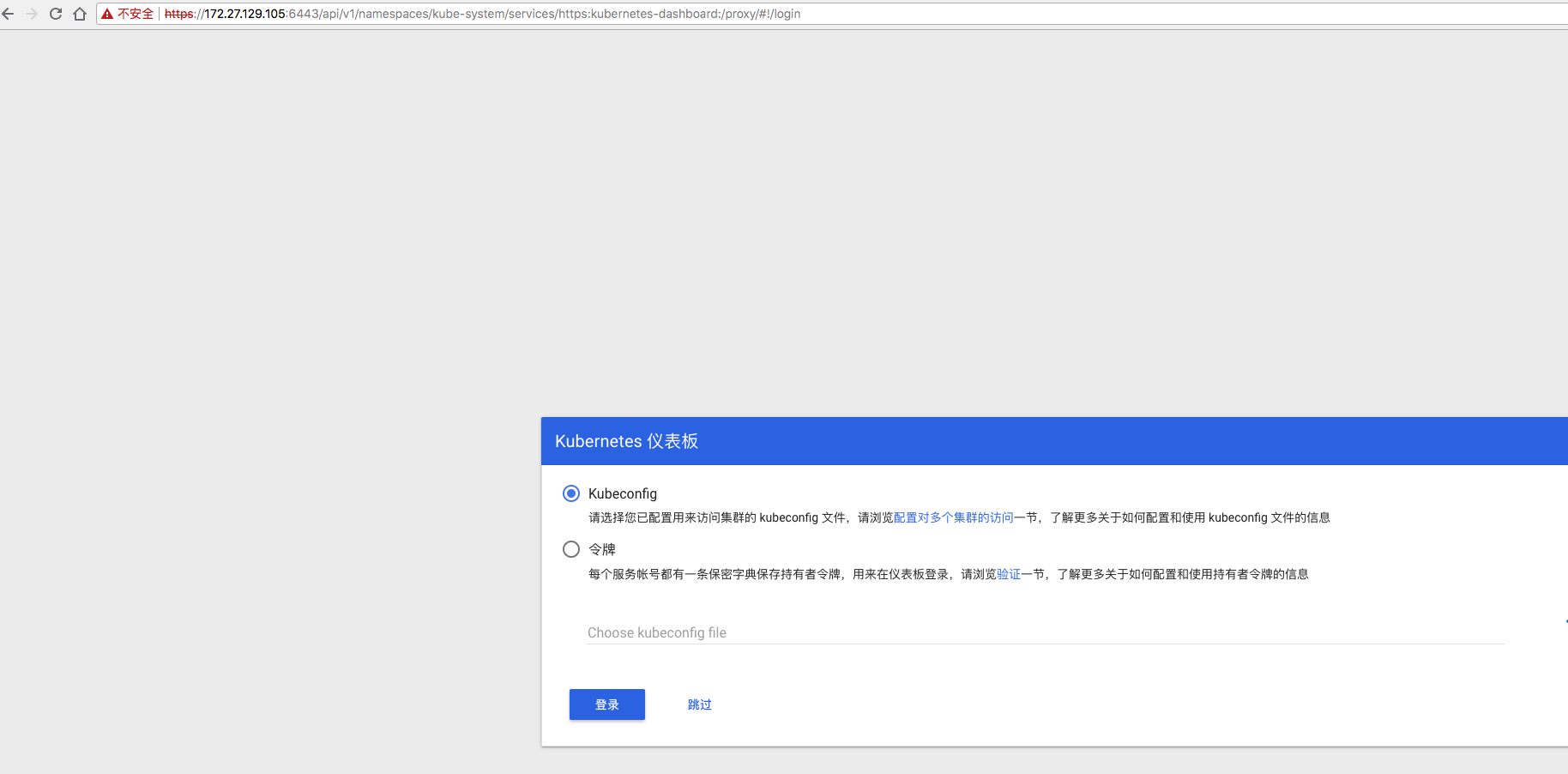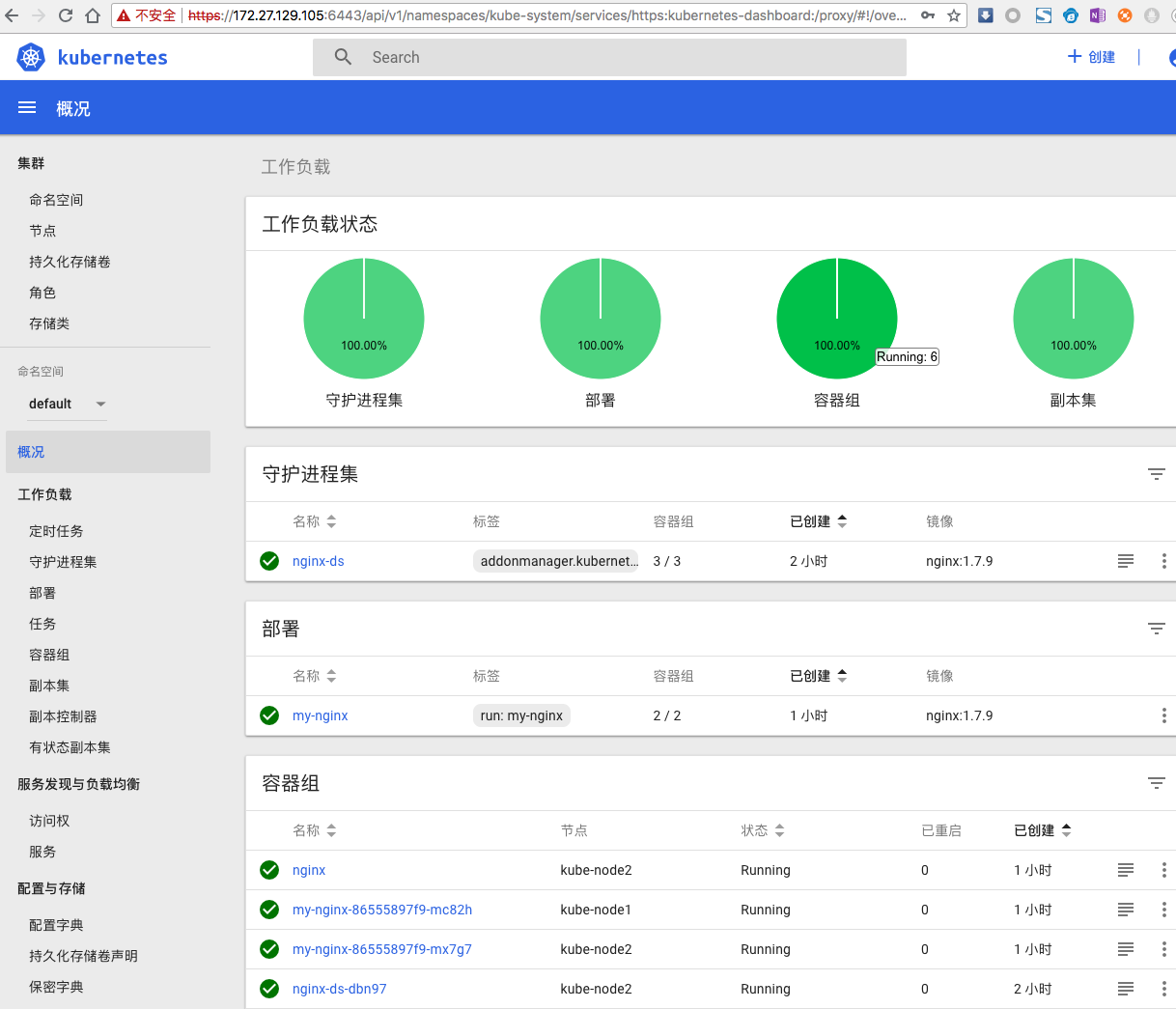标签:登录访问 dia match 命令 端口转发 ice show external src
将下载的 kubernetes-server-linux-amd64.tar.gz 解压后,再解压其中的 kubernetes-src.tar.gz 文件。
dashboard 对应的目录是:cluster/addons/dashboard。
$ pwd
/opt/k8s/kubernetes/cluster/addons/dashboard
$ cp dashboard-controller.yaml{,.orig}
$ diff dashboard-controller.yaml{,.orig}
33c33
< image: siriuszg/kubernetes-dashboard-amd64:v1.8.3
---
> image: k8s.gcr.io/kubernetes-dashboard-amd64:v1.8.3
$ cp dashboard-service.yaml{,.orig}
$ diff dashboard-service.yaml.orig dashboard-service.yaml
10a11
> type: NodePort
$ ls *.yaml
dashboard-configmap.yaml dashboard-controller.yaml dashboard-rbac.yaml dashboard-secret.yaml dashboard-service.yaml
$ kubectl create -f .
$ kubectl get deployment kubernetes-dashboard -n kube-system
NAME DESIRED CURRENT UP-TO-DATE AVAILABLE AGE
kubernetes-dashboard 1 1 1 1 2m
$ kubectl --namespace kube-system get pods -o wide
NAME READY STATUS RESTARTS AGE IP NODE
coredns-77c989547b-6l6jr 1/1 Running 0 58m 172.30.39.3 kube-node3
coredns-77c989547b-d9lts 1/1 Running 0 58m 172.30.81.3 kube-node1
kubernetes-dashboard-65f7b4f486-wgc6j 1/1 Running 0 2m 172.30.81.5 kube-node1
$ kubectl get services kubernetes-dashboard -n kube-system
NAME TYPE CLUSTER-IP EXTERNAL-IP PORT(S) AGE
kubernetes-dashboard NodePort 10.254.96.204 <none> 443:8607/TCP 2m
dashboard 的 --authentication-mode 支持 token、basic,默认为 token。如果使用 basic,则 kube-apiserver 必须配置 ‘--authorization-mode=ABAC‘ 和 ‘--basic-auth-file‘ 参数。
$ kubectl exec --namespace kube-system -it kubernetes-dashboard-65f7b4f486-wgc6j -- /dashboard --help
2018/06/13 15:17:44 Starting overwatch
Usage of /dashboard:
--alsologtostderr log to standard error as well as files
--apiserver-host string The address of the Kubernetes Apiserver to connect to in the format of protocol://address:port, e.g., https://localhost:8080. If not specified, the assumption is that the binary runs inside a Kubernetes cluster and local discovery is attempted.
--authentication-mode stringSlice Enables authentication options that will be reflected on login screen. Supported values: token, basic. Default: token.Note that basic option should only be used if apiserver has ‘--authorization-mode=ABAC‘ and ‘--basic-auth-file‘ flags set. (default [token])
--auto-generate-certificates When set to true, Dashboard will automatically generate certificates used to serve HTTPS. Default: false.
--bind-address ip The IP address on which to serve the --secure-port (set to 0.0.0.0 for all interfaces). (default 0.0.0.0)
--default-cert-dir string Directory path containing ‘--tls-cert-file‘ and ‘--tls-key-file‘ files. Used also when auto-generating certificates flag is set. (default "/certs")
--disable-settings-authorizer When enabled, Dashboard settings page will not require user to be logged in and authorized to access settings page.
--enable-insecure-login When enabled, Dashboard login view will also be shown when Dashboard is not served over HTTPS. Default: false.
--heapster-host string The address of the Heapster Apiserver to connect to in the format of protocol://address:port, e.g., https://localhost:8082. If not specified, the assumption is that the binary runs inside a Kubernetes cluster and service proxy will be used.
--insecure-bind-address ip The IP address on which to serve the --port (set to 0.0.0.0 for all interfaces). (default 127.0.0.1)
--insecure-port int The port to listen to for incoming HTTP requests. (default 9090)
--kubeconfig string Path to kubeconfig file with authorization and master location information.
--log_backtrace_at traceLocation when logging hits line file:N, emit a stack trace (default :0)
--log_dir string If non-empty, write log files in this directory
--logtostderr log to standard error instead of files
--metric-client-check-period int Time in seconds that defines how often configured metric client health check should be run. Default: 30 seconds. (default 30)
--port int The secure port to listen to for incoming HTTPS requests. (default 8443)
--stderrthreshold severity logs at or above this threshold go to stderr (default 2)
--system-banner string When non-empty displays message to Dashboard users. Accepts simple HTML tags. Default: ‘‘.
--system-banner-severity string Severity of system banner. Should be one of ‘INFO|WARNING|ERROR‘. Default: ‘INFO‘. (default "INFO")
--tls-cert-file string File containing the default x509 Certificate for HTTPS.
--tls-key-file string File containing the default x509 private key matching --tls-cert-file.
--token-ttl int Expiration time (in seconds) of JWE tokens generated by dashboard. Default: 15 min. 0 - never expires (default 900)
-v, --v Level log level for V logs
--vmodule moduleSpec comma-separated list of pattern=N settings for file-filtered logging
command terminated with exit code 2
$
为了集群安全,从 1.7 开始,dashboard 只允许通过 https 访问,如果使用 kube proxy 则必须监听 localhost 或 127.0.0.1,对于 NodePort 没有这个限制,但是仅建议在开发环境中使用。
对于不满足这些条件的登录访问,在登录成功后浏览器不跳转,始终停在登录界面。
参考:
https://github.com/kubernetes/dashboard/wiki/Accessing-Dashboard---1.7.X-and-above
https://github.com/kubernetes/dashboard/issues/2540
https://NodeIP:NodePort 地址访问 dashboard;如果使用了 VirtualBox,需要启用 VirtualBox 的 ForworadPort 功能将虚机监听的端口和 Host 的本地端口绑定。
可以在 Vagrant 的配置中指定这些端口转发规则,对于正在运行的虚机,也可以通过 VirtualBox 的界面进行配置:


启动代理:
$ kubectl proxy --address=‘localhost‘ --port=8086 --accept-hosts=‘^*$‘
Starting to serve on 127.0.0.1:8086
--accept-hosts 选项,否则浏览器访问 dashboard 页面时提示 “Unauthorized”;浏览器访问 URL:https://127.0.0.1:8086/api/v1/namespaces/kube-system/services/https:kubernetes-dashboard:/proxy
获取集群服务地址列表:
$ kubectl cluster-info
Kubernetes master is running at https://172.27.129.105:6443
CoreDNS is running at https://172.27.129.105:6443/api/v1/namespaces/kube-system/services/coredns:dns/proxy
kubernetes-dashboard is running at https://172.27.129.105:6443/api/v1/namespaces/kube-system/services/https:kubernetes-dashboard:/proxy
To further debug and diagnose cluster problems, use ‘kubectl cluster-info dump‘.
必须通过 kube-apiserver 的安全端口(https)访问 dashbaord,访问时浏览器需要使用自定义证书,否则会被 kube-apiserver 拒绝访问。
创建和导入自定义证书的步骤,参考:A.浏览器访问kube-apiserver安全端口
浏览器访问 URL:https://172.27.129.105:6443/api/v1/namespaces/kube-system/services/https:kubernetes-dashboard:/proxy/
对于 virtuabox 做了端口映射: https://127.0.0.1:6443/api/v1/namespaces/kube-system/services/https:kubernetes-dashboard:/proxy/

上面提到,Dashboard 默认只支持 token 认证,所以如果使用 KubeConfig 文件,需要在该文件中指定 token,不支持使用 client 证书认证。
kubectl create sa dashboard-admin -n kube-system
kubectl create clusterrolebinding dashboard-admin --clusterrole=cluster-admin --serviceaccount=kube-system:dashboard-admin
ADMIN_SECRET=$(kubectl get secrets -n kube-system | grep dashboard-admin | awk ‘{print $1}‘)
DASHBOARD_LOGIN_TOKEN=$(kubectl describe secret -n kube-system ${ADMIN_SECRET} | grep -E ‘^token‘ | awk ‘{print $2}‘)
echo ${DASHBOARD_LOGIN_TOKEN}
使用输出的 token 登录 Dashboard。
source /opt/k8s/bin/environment.sh
# 设置集群参数
kubectl config set-cluster kubernetes --certificate-authority=/etc/kubernetes/cert/ca.pem --embed-certs=true --server=${KUBE_APISERVER} --kubeconfig=dashboard.kubeconfig
# 设置客户端认证参数,使用上面创建的 Token
kubectl config set-credentials dashboard_user --token=${DASHBOARD_LOGIN_TOKEN} --kubeconfig=dashboard.kubeconfig
# 设置上下文参数
kubectl config set-context default --cluster=kubernetes --user=dashboard_user --kubeconfig=dashboard.kubeconfig
# 设置默认上下文
kubectl config use-context default --kubeconfig=dashboard.kubeconfig
用生成的 dashboard.kubeconfig 登录 Dashboard。

由于缺少 Heapster 插件,当前 dashboard 不能展示 Pod、Nodes 的 CPU、内存等统计数据和图表;
标签:登录访问 dia match 命令 端口转发 ice show external src
原文地址:https://www.cnblogs.com/linux20190409/p/10976996.html